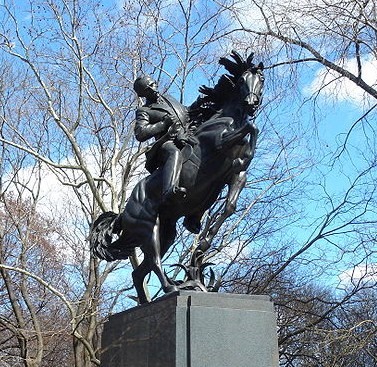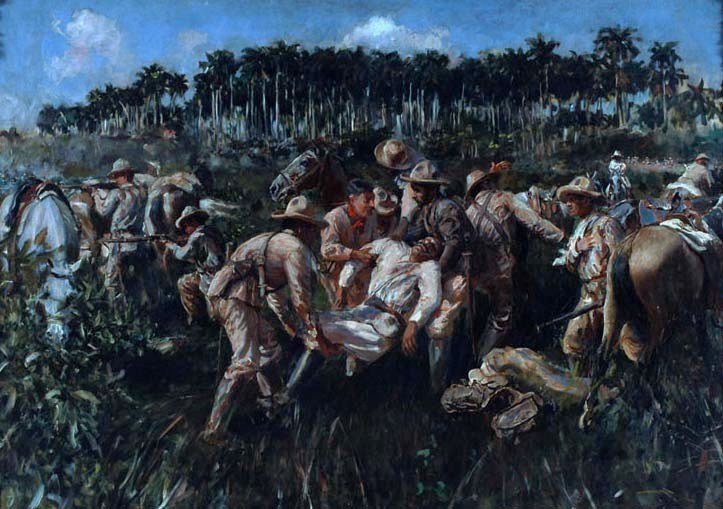|
Manuel Sanguily Garritte
Manuel Sanguily (March 26, 1848 – January 23, 1925) was a Cuban statesmen, independence activist, historian, and patriot who participated in the Ten Years' War. Biography Early life Manuel Sanguily y Garritte was born on March 26, 1848, in Havana, La Habana Province, Spanish Cuba. He was the younger brother of Julio Sanguily. Sanguily was educated in his early years at the El Salvador school under the mentorship of José de la Luz y Caballero. Ten Years' War From the United States, the Sanguily brothers landed in Camagüey Province on the Galvanic expedition led by Manuel de Quesada in December 1868. Manuel Sanguily and nine other patriots managed to land on Cayo Romano, crossed by canoe to La Guanaja, and enlisted in the mambises infantry. He served as a colonel in the Cuban Liberation Army during the Ten Years' War (1868–1878). Before the war's end, Manuel left the island with his brother Julio in 1876, departing to the United States. In April 1886, he published the tex ... [...More Info...] [...Related Items...] OR: [Wikipedia] [Google] [Baidu] |
Havana
Havana (; ) is the capital and largest city of Cuba. The heart of La Habana Province, Havana is the country's main port and commercial center.Cuba ''The World Factbook''. Central Intelligence Agency. It is the most populous city, the largest by area, and the List of metropolitan areas in the West Indies, second largest metropolitan area in the Caribbean region. The population in 2012 was 2,106,146 inhabitants, and its area is for the capital city side and 8,475.57 km2 for the metropolitan zone. Its official population was 1,814,207 inhabitants in 2023. Havana was founded by the Spanish Empire, Spanish in the 16th century. It served as a springboard for the Spanish colonization of the Americas, Spanish conquest of ... [...More Info...] [...Related Items...] OR: [Wikipedia] [Google] [Baidu] |
Manuel De Quesada Y Loynaz
Manuel de Quesada y Loynaz (March 29, 1833 - January 29, 1884) was a Cuban revolutionary and the first General-in-Chief of the Cuban Liberation Army who fought against Spain in the Ten Years' War. Early life Manuel de Quesada y Loynaz was born in Puerto Príncipe (now Camagüey Province), Spanish Cuba on March 29, 1833.Harper's Weekly. (1869). United States: Harper's Magazine Company. He was part of a distinguished Cuban family, with parents Pedro Manuel de Quesada and Carmen Loynaz y Miranda. His sister Ana de Quesada y Loynaz would later marry Carlos Manuel de Céspedes. Mexican Army Reform War In the mid-1850s, he left Cuba and relocated to Mexico. Quesada joined the Army of Mexico as a second lieutenant in 1856.Johnson, W. F. (2018). The History of Cuba: Volume III. (n.p.): Outlook Verlag. During the Reform War from 1857 to 1861, he fought on the side of the Mexican liberals and Benito Juárez. Amid a three-year civil war and the eventual defeat of the Mexican c ... [...More Info...] [...Related Items...] OR: [Wikipedia] [Google] [Baidu] |
William McKinley
William McKinley (January 29, 1843September 14, 1901) was the 25th president of the United States, serving from 1897 until Assassination of William McKinley, his assassination in 1901. A member of the Republican Party (United States), Republican Party, he led a realignment that made Republicans History of the Republican Party (United States), largely dominant in the industrial states and nationwide for decades. McKinley successfully led the U.S. in the Spanish–American War and oversaw a period of Manifest destiny, American expansionism, with the annexations of Hawaii, Puerto Rico, Guam, the Philippines, and American Samoa. McKinley was the last president to have served in the American Civil War; he was the only one to begin his service as an enlisted soldier, enlisted man and ended it as a brevet (military), brevet major. After the war, he settled in Canton, Ohio, where he practiced law and married Ida Saxton. In 1876, McKinley was elected to Congress, where he became the ... [...More Info...] [...Related Items...] OR: [Wikipedia] [Google] [Baidu] |
Calixto García
Calixto García y Íñiguez (August 4, 1839 – December 11, 1898) was a Cuban general in three Cuban uprisings, part of the Cuban War for Independence: the Ten Years' War, the Little War, and the War of 1895, itself sometimes called the Cuban War for Independence, which initiated the Spanish–American War, ultimately resulting in national independence for Cuba. Ancestry and progeny García was born in Holguín to parents of Cuban '' Criollo'' descent. He was a large, strong, educated man with a short temper. García was the grandson of Calixto García de Luna e Izquierdo, who had fought as a royalist in the Battle of Carabobo in 1821 during the Venezuelan War of Independence. His grandmother was Maria de los Angeles Gonzalez, said to be the daughter of a ''cacique'' from Valencia, Venezuela. His grandfather (who had dropped the aristocratic "de Luna" upon taking refuge in Cuba) had been jailed on March 18, 1837, for demanding emancipation of slaves, constitutional fre ... [...More Info...] [...Related Items...] OR: [Wikipedia] [Google] [Baidu] |
Death Anniversary
A death anniversary (or deathday) is the anniversary of the death of a person. It is the opposite of birthday. It is a custom in several Asian cultures, including Azerbaijan, Armenia, Cambodia, China, Georgia, Hong Kong, Taiwan, India, Myanmar, Iran, Israel, Japan, Bangladesh, Korea, Nepal, Pakistan, the Philippines, Russia, Sri Lanka and Vietnam, as well as in other places with significant overseas Chinese, Japanese, Jewish, Korean, and Vietnamese populations, to observe the anniversary on which a family member or other significant individual died. There are also similar memorial services that are held at different intervals, such as every week. Although primarily a manifestation of ancestor worship, the tradition has also been associated with Confucianism and Buddhism (in East Asian cultural civilizations) or Hinduism and Buddhism (South Asia but mainly in India, Nepal and Sri Lanka and Southeast Asia). In Judaism (the majority religion of Israel), such a commemoration i ... [...More Info...] [...Related Items...] OR: [Wikipedia] [Google] [Baidu] |
José Martí
José Julián Martí Pérez (; 28 January 1853 – 19 May 1895) was a Cuban nationalism, nationalist, poet, philosopher, essayist, journalist, translator, professor, and publisher, who is considered a Cuban national hero because of his role in the liberation of his country from Spain. He was also an important figure in Latin American literature. He was a political activist and is considered an important philosopher and Political philosophy, political theorist. Through his writings and political activity, he became a symbol of Cuba's bid for independence from the Spanish Empire in the 19th century and is referred to as the "Apostle of Cuban Independence". From adolescence on, he dedicated his life to the promotion of liberty, political independence for Cuba, and intellectual independence for all Hispanic America, Spanish Americans; his death was used as a cry for Cuban independence from Spain by both the Cuban revolutionaries and those Cubans previously reluctant to start a revolt ... [...More Info...] [...Related Items...] OR: [Wikipedia] [Google] [Baidu] |
Chickering Hall (New York City, 1875)
Chickering Hall (1875 - 1893) was a concert and music hall in Manhattan, New York City, New York, located on Fifth Avenue. History Chickering Hall, commissioned by Chickering & Sons, was situated at the northwest corner of Fifth Avenue and 18th Street in the New York City borough of Manhattan. It was designed by the American architect George B. Post and F.C. Murray. The building housed a music store, piano warehouse, and concert hall. Above the ground-level salesroom, its 1,450-seat auditorium, located on the second and third floors, hosted concerts, lectures, and conferences. At the inauguration of the new music hall on November 15, 1875, German pianist Hans von Bülow gave his first New York City performance. The concert hall was managed by Edward H. Colell in 1891 and was still under the ownership of Chickering and Sons. In 1893, the building was entirely repurposed into a retail space for John Wanamaker's department store, taking over city piano sales. The original Chickerin ... [...More Info...] [...Related Items...] OR: [Wikipedia] [Google] [Baidu] |
Cuban War Of Independence
The Cuban War of Independence (), also known in Cuba as the Necessary War (), fought from 1895 to 1898, was the last of three liberation wars that Cuba fought against Spain, the other two being the Ten Years' War (1868–1878) and the Little War (1879–1880). During the war, Spain sent 220,285 soldiers to Cuba—according to the Library of Congress, the largest army to cross the Atlantic until World War II. The final three months of the conflict escalated to become the Spanish–American War, with United States forces being deployed in Cuba, Puerto Rico, and the Philippines against Spain. Historians disagree as to the extent that United States officials were motivated to intervene for humanitarian reasons but agree that yellow journalism exaggerated atrocities attributed to Spanish forces against Cuban civilians. Background During the years 1879–1888 of the so-called "Rewarding Truce", lasting for 17 years from the end of the Ten Years' War in 1878, there were fundament ... [...More Info...] [...Related Items...] OR: [Wikipedia] [Google] [Baidu] |
Separatism
Separatism is the advocacy of cultural, ethnic, tribal, religious, racial, regional, governmental, or gender separation from the larger group. As with secession, separatism conventionally refers to full political separation. Groups simply seeking greater autonomy are usually not considered separatists. Some discourse settings equate separatism with religious segregation, racial segregation, or sex segregation, while other discourse settings take the broader view that separation by choice may serve useful purposes and is not the same as government-enforced segregation. There is some academic debate about this definition, and in particular how it relates to secessionism, as has been discussed online. Separatist groups practice a form of identity politics, or political activity and theorizing founded in the shared experiences of the group's members. Such groups believe attempts at integration with dominant groups compromise their identity and ability to pursue greater self-determina ... [...More Info...] [...Related Items...] OR: [Wikipedia] [Google] [Baidu] |
Freedom Of The Press
Freedom of the press or freedom of the media is the fundamental principle that communication and expression through various media, including printed and electronic Media (communication), media, especially publication, published materials, should be considered a right to be exercised freely. Such freedom implies the absence of interference from an overreaching State (polity), state; its preservation may be sought through a constitution or other legal protection and security. It is in opposition to paid press, where communities, police organizations, and governments are paid for their copyrights. Without respect to governmental information, any government may distinguish which materials are public or protected from disclosure to the public. State materials are protected due to either one of two reasons: the classified information, classification of information as sensitive, classified, or secret, or the relevance of the information to protecting the national interest. Many governm ... [...More Info...] [...Related Items...] OR: [Wikipedia] [Google] [Baidu] |
Matanzas
Matanzas (Cuban ; ) is the capital of the Cuban province of Matanzas Province, Matanzas. Known for its poets, culture, and Afro-American religions, Afro-Cuban folklore, it is located on the northern shore of the island of Cuba, on the Bay of Matanzas (Spanish ''Bahia de Matanzas''), east of the capital Havana and west of the resort town of Varadero. Matanzas is called the ''City of Bridges'', for the seventeen bridges that cross the three rivers that traverse the city (Rio Yumuri, San Juan, and Canimar). For this reason it was referred to as the "Venice of Cuba." It was also called "La Atenas de Cuba" ("The Athens of Cuba") for its poets. Matanzas is known as the birthplace of the music and dance traditions danzón and Cuban rumba, rumba. History Matanzas was founded on October 12, 1693, as ''San Carlos y San Severino de Matanzas''. This followed a royal decree ("''real cédula''") issued on September 25, 1690, which decreed that the bay and port of Matanzas be settled ... [...More Info...] [...Related Items...] OR: [Wikipedia] [Google] [Baidu] |






